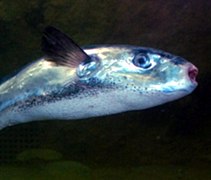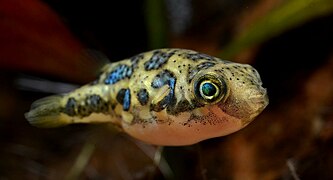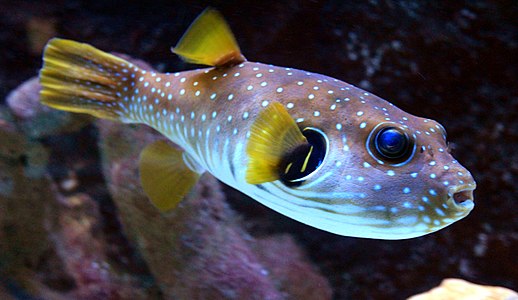Tetraodontidae
| Puffers[1] | |
|---|---|

| |
| Inflated white-spotted puffer | |
| Scientific classification | |
| Domain: | Eukaryota |
| Kingdom: | Animalia |
| Phylum: | Chordata |
| Class: | Actinopterygii |
| Order: | Tetraodontiformes |
| Suborder: | Tetraodontoidei |
| Family: | Tetraodontidae Bonaparte, 1832 |
| Type species | |
| Genera | |

Tetraodontidae is a
The majority of pufferfish species are
The species Torquigener albomaculosus was described by David Attenborough as "the greatest artist of the animal kingdom" due to the males' unique habit of wooing females by creating nests in sand composed of complex geometric designs.[4]
Taxonomy
The family name comes from the name of its type genus
Genera
The Tetraodontidae contain 193 species of puffers in 28 genera:[1][6]
- Amblyrhynchotes Troschel, 1856
- Arothron Müller, 1841
- Auriglobus Kottelat, 1999
- Canthigaster Swainson, 1839
- Carinotetraodon Benl, 1957
- Chelonodon Müller, 1841
- Chonerhinos Bleeker, 1854
- Colomesus Gill, 1884
- Contusus Whitley, 1947
- Dichotomyctere Duméril, 1855
- Ephippion Bibron, 1855
- Feroxodon Su, Hardy et Tyler, 1986
- GuentheridiaGilbert et Starks, 1904
- Javichthys Hardy, 1985
- Leiodon Swainson, 1839
- Lagocephalus Swainson, 1839
- Marilyna Hardy, 1982
- Omegophora Whitley, 1934
- Pelagocephalus Tyler & Paxton, 1979
- Polyspina Hardy, 1983
- Pao Kottelat, 2013
- Reicheltia Hardy, 1982
- Sphoeroides Anonymous, 1798
- Takifugu Abe, 1949
- Tetractenos Hardy, 1983
- Tetraodon Linnaeus, 1758
- Torquigener Whitley, 1930
- TyleriusHardy, 1984
-
Canthigaster valentini
-
Ephippion guttifer
-
Sphoeroides spengleri
-
Tetractenos glaber
-
Tetraodon mbu
-
Carinotetraodon travancoricus
Morphology
Pufferfish are typically small to medium in size, although a few species such as the Mbu pufferfish can reach lengths greater than 50 cm (20 in).[7]
Tetraodontiformes, or pufferfish, are most significantly characterized by the beak-like four teeth – hence the name combining the Greek terms "tetra" for four and "odous" for tooth.[8] Each of the top and bottom arches is fused together with a visible midsagittal demarcation, which are used to break apart and consume small crustaceans. The lack of ribs, a pelvis, and pectoral fins are also unique to pufferfish. The notably missing bone and fin features are due to the pufferfish' specialized defense mechanism, expanding by sucking in water through an oral cavity.[9]
Pufferfish can also have many varied structures of caltrop-like dermal spines, which account for the replacement of typical fish scales, and can range in coverage extent from the entire body, to leaving the frontal surface empty.[10] Tetraodontidae typically have smaller spines than the sister family Diodontidae, with some spines not being visible until inflation.
Distribution
They are most diverse in the
Ecology and life history
Most pufferfish species live in marine or
Natural defenses
The puffer's unique and distinctive natural defenses help compensate for its slow locomotion. It moves by combining
The pufferfish's secondary defense mechanism, used if successfully pursued, is to fill its extremely elastic
Larval pufferfish are chemically defended by the presence of TTX on the surface of skin, which causes predators to spit them out.[14]
Not all puffers are necessarily poisonous; the flesh of the
Puffers are able to move their eyes independently, and many species can change the color or intensity of their patterns in response to environmental changes. In these respects, they are somewhat similar to the terrestrial
Dolphins have been filmed expertly handling pufferfish amongst themselves in an apparent attempt to get intoxicated or enter a trance-like state.[18]
Reproduction
Many marine puffers have a
Reproduction in freshwater species varies quite a bit. The dwarf puffers court with males following females, possibly displaying the crests and keels unique to this subgroup of species. After the female accepts his advances, she will lead the male into plants or another form of cover, where she can release eggs for fertilization. The male may help her by rubbing against her side. This has been observed in captivity, and they are the only commonly captive-spawned puffer species.
Target-group puffers have also been spawned in aquaria, and follow a similar courting behavior, minus the crest/keel display. Eggs are laid, though, on a flat piece of slate or other smooth, hard material, to which they adhere. The male will guard them until they hatch, carefully blowing water over them regularly to keep the eggs healthy. His parenting is finished when the young hatch and the fry are on their own.
In 2012, males of the species Torquigener albomaculosus were documented while carving large and complex geometric, circular structures in the seabed sand in Amami Ōshima, Japan. The structures serve to attract females and to provide a safe place for them to lay their eggs.[19]
Information on breeding of specific species is very limited.
Diet
Pufferfish diets can vary depending on their environment. Traditionally, their diet consists mostly of algae and small invertebrates. They can survive on a completely vegetarian diet if their environment is lacking resources, but prefer an omnivorous food selection. Larger species of pufferfish are able to use their beak-like front teeth to break open clams, mussels, and other shellfish. Some species of pufferfish have also been known to enact various hunting techniques ranging from ambush to open-water hunting.[21]
- Spots, stripes and elaborations
-
Striped puffer
-
Elaborategiant or mbu puffer
Evolution
The tetraodontids have been estimated to have diverged from
Poisoning
Pufferfish can be lethal if not served properly. Puffer poisoning usually results from consumption of incorrectly prepared puffer soup, fugu chiri, or occasionally from raw puffer meat, sashimi fugu. While chiri is much more likely to cause death, sashimi fugu often causes intoxication, light-headedness, and numbness of the lips.[24] Pufferfish tetrodotoxin deadens the tongue and lips, and induces dizziness and vomiting, followed by numbness and prickling over the body, rapid heart rate, decreased blood pressure, and muscle paralysis. The toxin paralyzes the diaphragm muscle and stops the person who has ingested it from breathing. People who live longer than 24 hours typically survive, although possibly after a coma lasting several days.
The source of tetrodotoxin in puffers has been a matter of debate,[25] but it is increasingly accepted that bacteria in the fish's intestinal tract are the source.[26]
-
Arothron hispidusat Big Island of Hawaii
-
Man with a guineafowl puffer in Costa Rica
-
Fisherman handpicks a puffer from his day's catch before throwing it back to prevent poisoning. Tarkwa bay, Lagos
Philippines
In September 2012, the
Thailand
Pufferfish, called pakapao in Thailand, are usually consumed by mistake. They are often cheaper than other fish, and because they contain inconsistent levels of toxins between fish and season, there is little awareness or monitoring of the danger. Consumers are regularly hospitalized and some even die from the poisoning.
United States
Cases of neurological symptoms, including numbness and tingling of the lips and mouth, have been reported to rise after the consumption of puffers caught in the area of Titusville, Florida, US. The symptoms generally resolve within hours to days, although one affected individual required intubation for 72 hours.[28] As a result, Florida banned the harvesting of puffers from certain bodies of water.[29]
Treatment
Treatment is mainly supportive and consists of intestinal decontamination with
See also
- Shimonoseki – Japanese city known for its locally caught pufferfish
- Toado – common Australian name for local varieties of pufferfish
References
- ^ a b c Froese, R.; D. Pauly (eds.). "Family Tetraodontidae – Puffers". FishBase. Retrieved 2017-08-23.
- ISBN 978-0-03-015431-7.
the encyclopedia of fish cookery.
- ^ .
- ^ "Courtship, Life Story – BBC One". BBC. Retrieved 2017-10-05.
- ^ Scharpf, Christopher (11 September 2023). "Family TETRAODONTIDAE" (PDF). The ETYFish Project. Retrieved 1 April 2024.
- ^ Eschmeyer, WN; Fong, JD, eds. (July 31, 2017). "Species by family/subfamily in the Catalog of Fishes". California Academy of Sciences. Retrieved 2021-10-02.
- ^ ISBN 978-0-12-547665-2.
- ^ "Puffer | fish | Britannica". Encyclopædia Britannica. Retrieved 2023-02-02.
- JSTOR 1447344.
- PMID 31353167.
- ^ Kottelat, M. (2013): The Fishes of the Inland Waters of Southeast Asia: A Catalogue and Core Bibliography of the Fishes Known to Occur in Freshwaters, Mangroves and Estuaries. The Raffles Bulletin of Zoology, 2013, Supplement No. 27: 1–663.
- ^ Roberts, Tyson R. (1982). The Southeast Asian freshwater pufferfish genus Chonerhinos (Tetraodontidae), with descriptions of new species. Proceedings of the California Academy of Sciences 43: 1–16.
- JSTOR 1447344.
- PMID 24279996.
- ^ "Unterwasserfotos – Ocean-Photo". Ocean-photo.de. Retrieved 2012-09-07.
- ^ "Big poison, little fish". Key West Aquarium, Florida. 2019. Retrieved 21 May 2019.
- PMID 19019790.
- ^ Nuwer, Rachel (2013-12-30). "Dolphins Seem to Use Toxic Pufferfish to Get High". Smithsonian.com. Retrieved 2019-04-16.
- ^ Heller, Jill (September 21, 2012). "Japan Underwater 'Crop Circles' Mystery Finally Solved". International Business Times. Retrieved September 23, 2012.
- .
- ^ "Puffer Fish: Fun Facts & Photos of Puffer Fish – (Tetraodontidae)". Our Beautiful Planet. 2017-02-07. Retrieved 2017-03-30.
- S2CID 39231771.
- .
- PMID 24368916.
- ^ Lehman, Elizabeth M. (2006). Egg Toxicity and Egg Predation in Rough-Skinned Newts (Doctoral dissertation). Proquest Dissertations and Theses database. UMI No.: 3229594. pp. 32–33.
- ISBN 978-0-12-374286-5.
- ^ Julie S. Alipala (2012-09-07). "BFAR renews warning vs. eating puffer fish". Philippine Daily Inquirer. Retrieved 2012-09-07.
- PMID 11990235. Retrieved 30 July 2016.
- ^ "Prohibition on Take of Puffer Fish in Volusia, Brevard, Indian River, St. Lucie, and Martin Counties". Florida Fish and Wildlife Conservation Commission. Archived from the original on August 24, 2016. Retrieved 30 July 2016.
Further reading
- Arreola, V.I.; Westneat, M.W. (1996). "Mechanics of propulsion by multiple fins: kinematics of aquatic locomotion in the burrfish (Chilomycterus schoepfi)". Proceedings of the Royal Society of London B. 263 (1377): 1689–1696. S2CID 109972375.
- Ebert, Klaus (2001): The Puffers of Fresh and Brackish Water, Aqualog, ISBN 3-931702-60-X.
- Gordon, M.S.; Plaut, I.; Kim, D. (1996). "How puffers (Teleostei: Tetraodontidae) swim". Journal of Fish Biology. 49 (2): 319–328. .
- Plaut, I.; Chen, T. (2003). "How small puffers (Teleostei: Tetraodontidae) swim". Ichthyological Research. 50 (2): 149–153. S2CID 33832068.


















